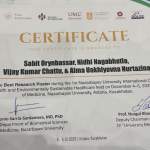UNU-CRIS PhD Fellow Justine Miller Presents Paper at Sunbelt Conference 2023

Justine Miller, PhD Fellow at UNU-CRIS, presents paper on Measuring the Level of Overlap between Trade Agreements at the Sunbelt 2023 Conference in Portland, Oregon (hybrid) on Saturday, 1 July 2023.
Authors: Justine Miller and Samuel Standaert
Abstract:
The number of trade agreements worldwide has greatly increased since the 1990s. In particular, regional trade agreements have proliferated and this has given rise to a complex trading scene, where countries are often simultaneously members of multiple agreements. This creates a network of interwoven agreements with intricate and, at times, contradicting economic provisions. This chaotic structure characterizing modern regional integration has often been referred to as the "Spaghetti Bowl". The Spaghetti Bowl plays a key role in the world trade scene since it can reduce the trade gains normally achieved when signing trade agreements. However, the literature that evaluates the gains from joining such agreements often entirely ignores the Spaghetti Bowl or only partially accounts for it. The main reason for this gap is the notable absence of a measure of the phenomenon. In this paper, we address this need and use network analysis to develop a measure. To create a network of overlapping trade agreements, we use historical data on regional trade agreements, ranging from 1910 to 2020. This database not only allows us to study the overlap in membership, but for a subset of the data, we can also compare the similarity of agreements on different policy areas dealing with economic integration. Building on this data, we operationalize the network by representing the agreements as nodes and the overlap between them as the edges. The overlaps in membership and content are represented as separate layers. Using centrality measures we then study node characteristics or network typology across both network layers. The node characteristics mainly inform us of the individual contribution of specific agreements to the Spaghetti Bowl. Characteristics at the network level are more informative to describe the overall state of the Spaghetti Bowl. In turn, we develop a general measure of overlap at the node level that captures the contribution of each agreement to the Spaghetti Bowl. We first create a series of simulated random graphs and construct the measure by testing it on these graphs. In this manner, the measure is less sensitive to different possible data structures. In turn, we apply it to our data and analyze our findings. To test the validity of our measure, we also consider alternative network structures such as bipartite graphs, where the two types of nodes are countries and agreements. Overall, the contributions of this paper are twofold. First, we create a measure of the Spaghetti Bowl that captures both the overlap in membership and content between trade agreements. Second, we describe the Spaghetti Bowl at the global and local levels, identifying the countries and agreements that contribute the most to the phenomenon.
Please click here for more information about the Sunbelt 2023 Conference.




